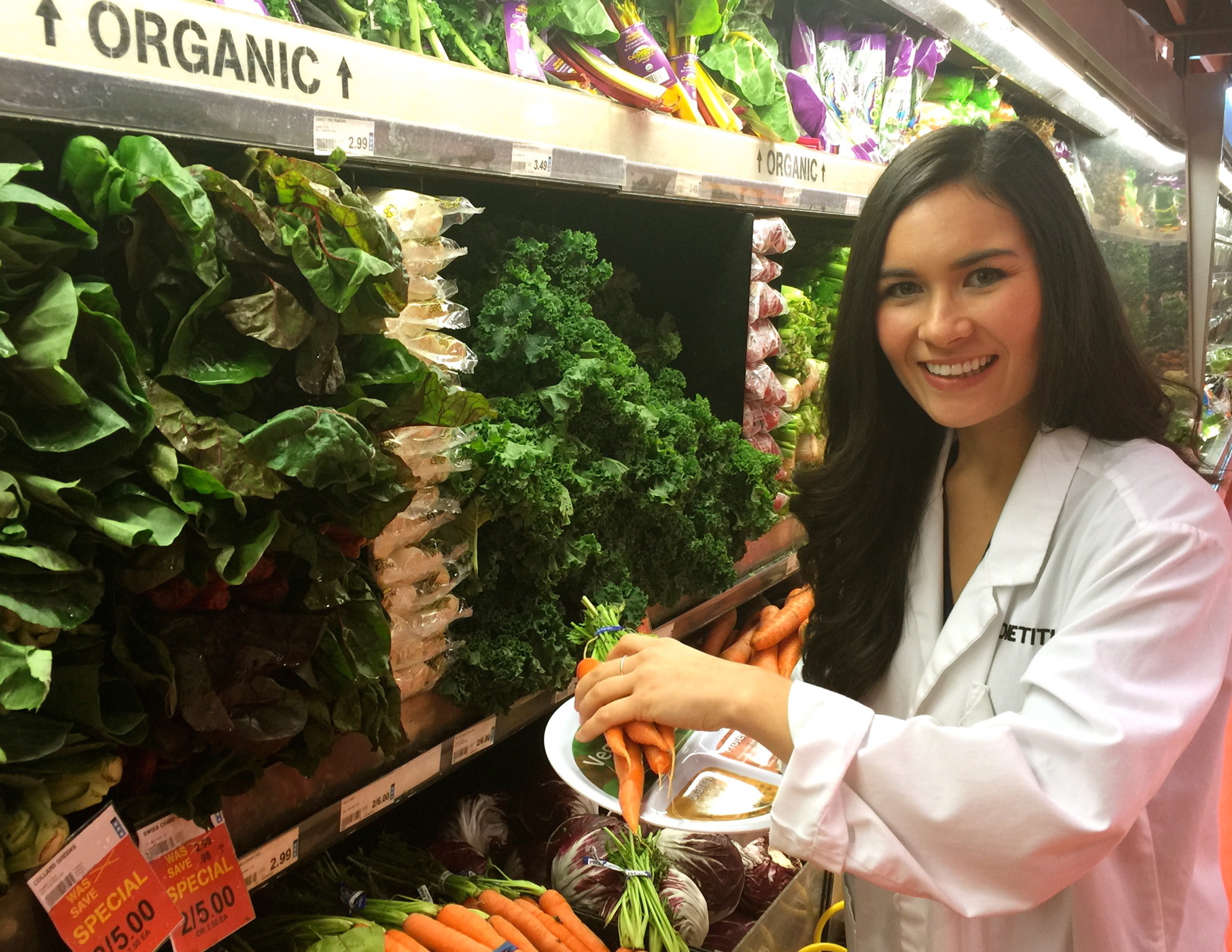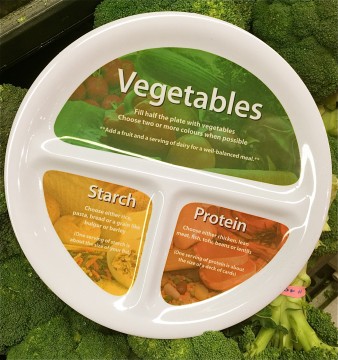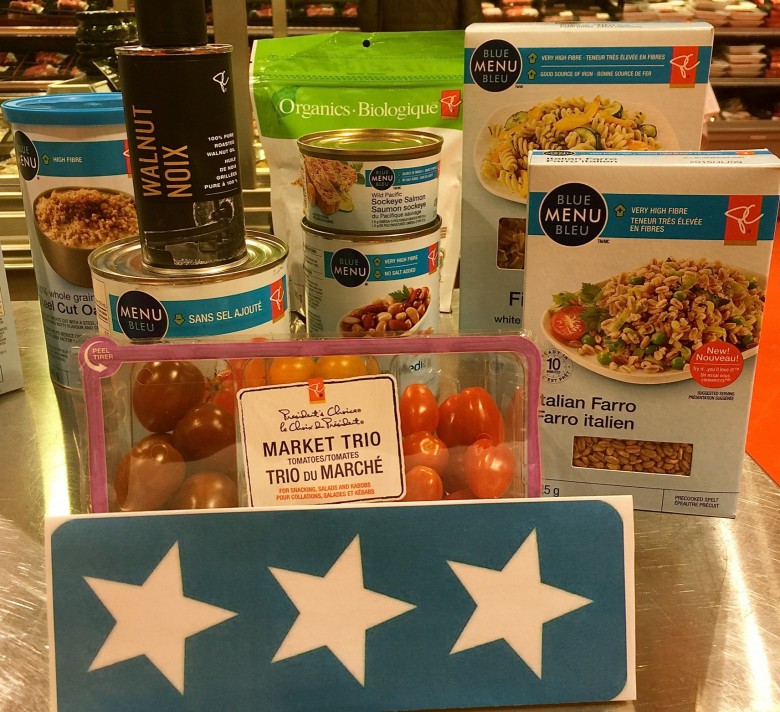Sometimes grocery shopping can be overwhelming. We’re overloaded with information coming from everywhere and everyone. Just take a look at Facebook and even our friends are sharing about food choices and our kids are coming home with ideas from school.
I had seen posters near the entrance of my Loblaw store that advertised a dietician who could any questions that you have about healthy eating and grocery shopping. Best of all, the service is free! The registered dietician will help with your basic questions but she, or he, will also help guide you with choices for specific dietary needs—celiac, lactose-free, gluten sensitivities, weight-loss, balanced family meals, diabetics and more. But on this day, I visited with Laura because I wanted to clear up some confusion and to find out more about the Guiding Stars I see on shelf tags. Here’s what we chatted about!
Plate the veggies first!
“What do you put on your plate first?” Laura had asked me. I had mentioned that I usually serve up the starch first(rice, pasta, potatoes) but then she pulled out a portioned visual plate that changed the order in which I serve food. She suggested that we start with the vegetables on the plate. We have a tendency to want to fill a plate so starting with veggies and making it half the plateful then the protein and starch should really only be a fist-size portion at most is a better way to portion understanding.
Explain whole grain?
You want whole grain to be the first ingredient on the label. If it says “whole wheat” it doesn’t mean you’re getting the whole grain. As a guideline a serving size of bread is about 30 grams. A good rule of thumb is to get at least 2 grams of fibre with your serving. Most Canadians only achieve half of the recommended daily intake of fibre, that’s why we want to look for whole grains. Refined means that it’s using the carbohydrate rich part of the grain. The ‘bran” and the “germ” of the grain contain the fibre, vitamins and minerals. Shasha and Stonemill brands have “Guiding Stars” noted which means they’re better choices for nutrition.
Should we go gluten-free?
Some people think that this is a better option than gluten containing bread. However, the thing with gluten-free bread is that it might not necessarily contain any or much fibre in it and it can be higher in fat. Many of the gluten-free breads do not have Guiding Star recognition.
Laura told me that people are starting to buy gluten-free for their families that don’t have gluten sensitivities but it’s not necessarily the best option. “If you don’t have a health related issue or particular diet restrictions like gluten-free, it’s not necessarily benefitting you or your family. It’s better, say in the case of bread, that you choose a bread that contains the fibre that is important in our diets.
Are carbs really that bad for us?
We often eat more bread and carbohydrates than we need. For example, when we eat pasta we tend to plate that part first and then load on the meat and sauce. That tends to be equivalent of four recommended servings – remember your fist as a guideline? The problem isn’t the pasta itself, it’s the quantity that we’re consuming.
But really, carbohydrates is our main source of energy so it is good to have some carbs in our diet.
What are some good carbohydrates to have?
Sweet potatoes (with skin on because it’s got fibre – just give them a good scrub before cooking) are a great source of carbohydrates. Italian Farro is a great option as well. It’s like a type of spelt so it does contain wheat but it does have protein in it and it’s a more hearty grain so this is a good option to have to include in salad or stir-fries.
What’s the 80 / 20 rule?
There are times you may want mac and cheese or have a treat. Try to shop with the Guiding Stars in mind. Shop the perimeters of the store (generally where all the fresh foods and produce are) and be cautious of what you’re eating as a family at least 80 per cent of the time. The remaining 20 per cent, it’s okay to bend and not worry too much about nutrition because there are times when we are in a hurry or haven’t made it to the grocery store to replenish. It’s okay to reach for what’s can be quick and in the pantry. Just try to make the better choices when you’re shopping if you can.
What about treats? I try not to call them “treats” at home
Good idea! If we stop labelling dessert and sweet sugary stuff as “treats” then they won’t seem like the reward at to finishing a meal making that part of the meal the prize. If you have a satisfying meal then dessert isn’t necessarily the hero at the dinner table. Food should be about eating and enjoying as well as nutrition needs. But don’t feel bad about having dessert either!
What about “Superfood” labels I keep hearing?
It’s good to have a variety in your diet. Quinoa, spelt, and kale are great to have in your diet but superfoods, while they are great for you, seem to elevate that particular food and tends to eliminate other choices available to us that also have great benefits. So, don’t just focus on the kale but also having other colourful vegetables as well.
I heard Kale is hard to digest?
Everybody is individual. Some people have a hard time digesting raw kale but want to eat it. I would suggest playing around with cooking it to see if that agrees with you more. Kale is quite rough so maybe try baby kale as an option. Kids also love baked kale chips! You can easily make them at home.
Explain the Guiding Stars system to me?
You’ll see the Guiding Star rating on the shelf tags throughout the store. The ratings are based on national and international dietary recommendations and aligns with Canadian regulations as established by Health Canada. Loblaws and affiliated stores have committed to providing this information to customers. It’s an impartial, patented food rating system that rates food based on nutrient density. You’ll see ratings of 1, 2 or 3 stars. If the shelf tag has no stars it simply means the food doesn’t meet the nuritutional criteria, the food is not rated yet or that the product contains fewer than 5 calories per serving (e.g. bottled water or spices). It’s not intended to tell you what to buy but rather point you towards nutritious choices. It’s not influenced by price, brands or manufacturer trade groups. You can find out more here: Guiding Stars
There’s also a reference book available in each store that helps people understand the nutrition and food options if someone wanted a quick check on something.
Thanks to Laura for meeting up and clearing up some confusing food information!



Leave a Reply